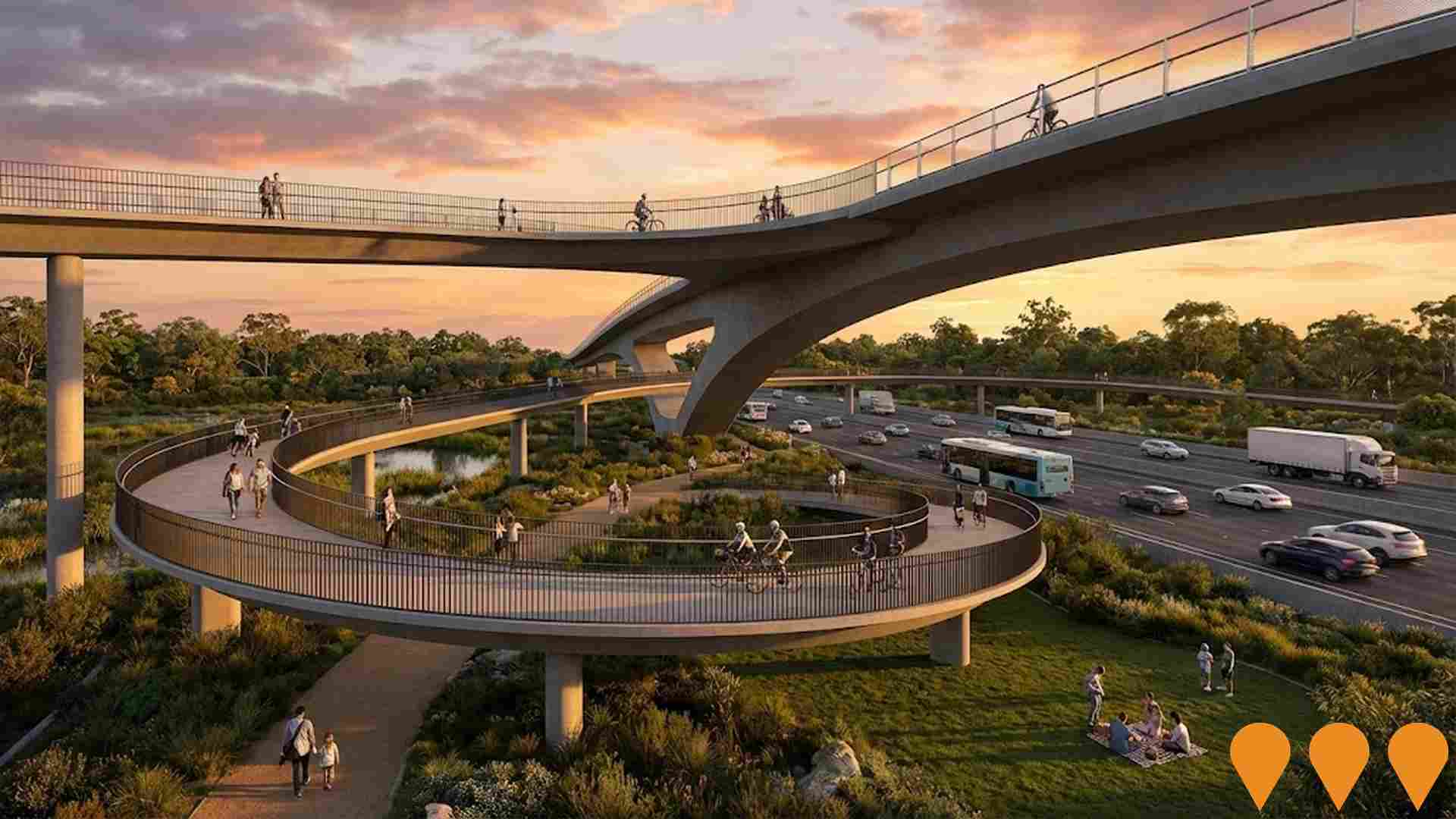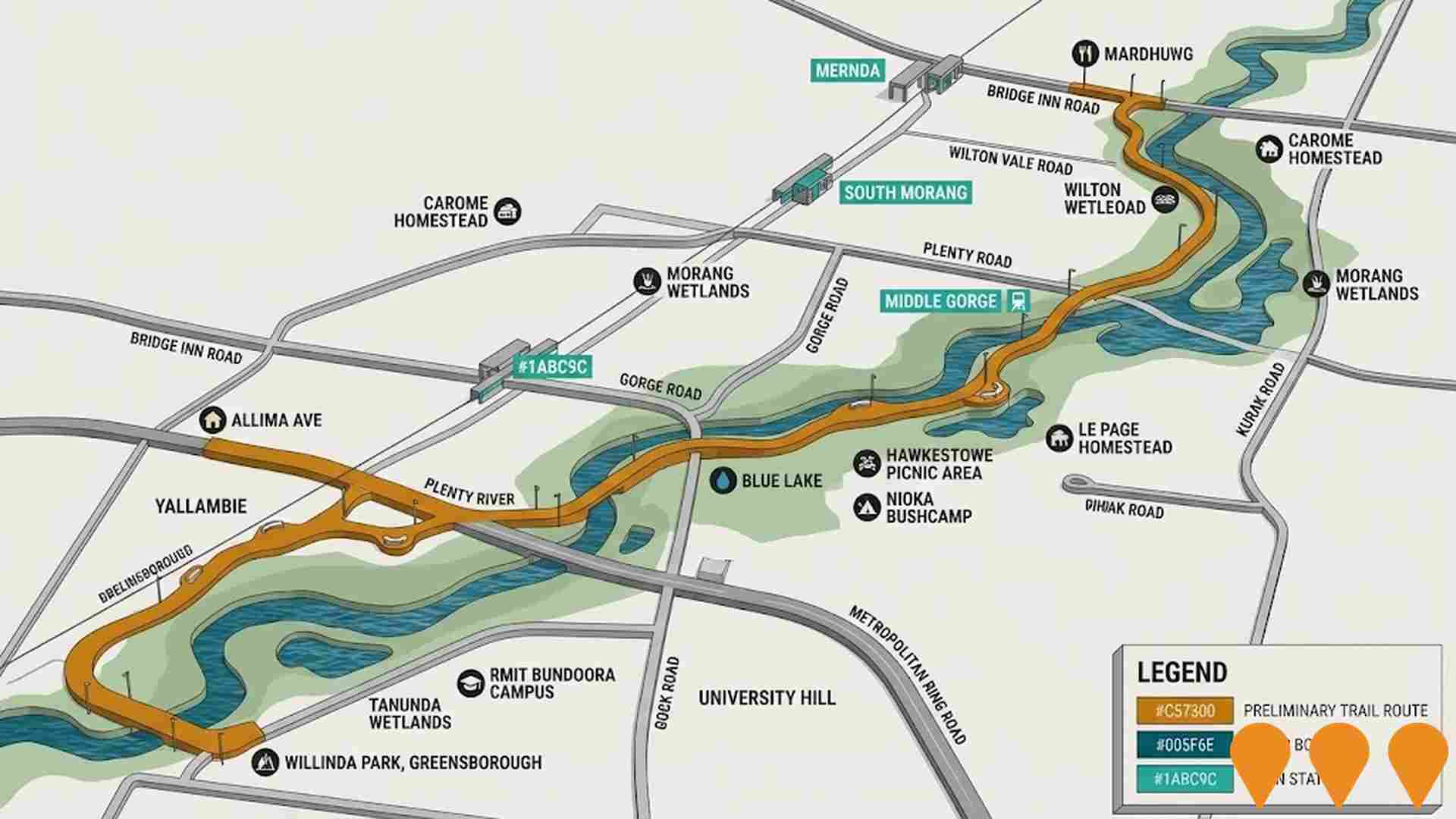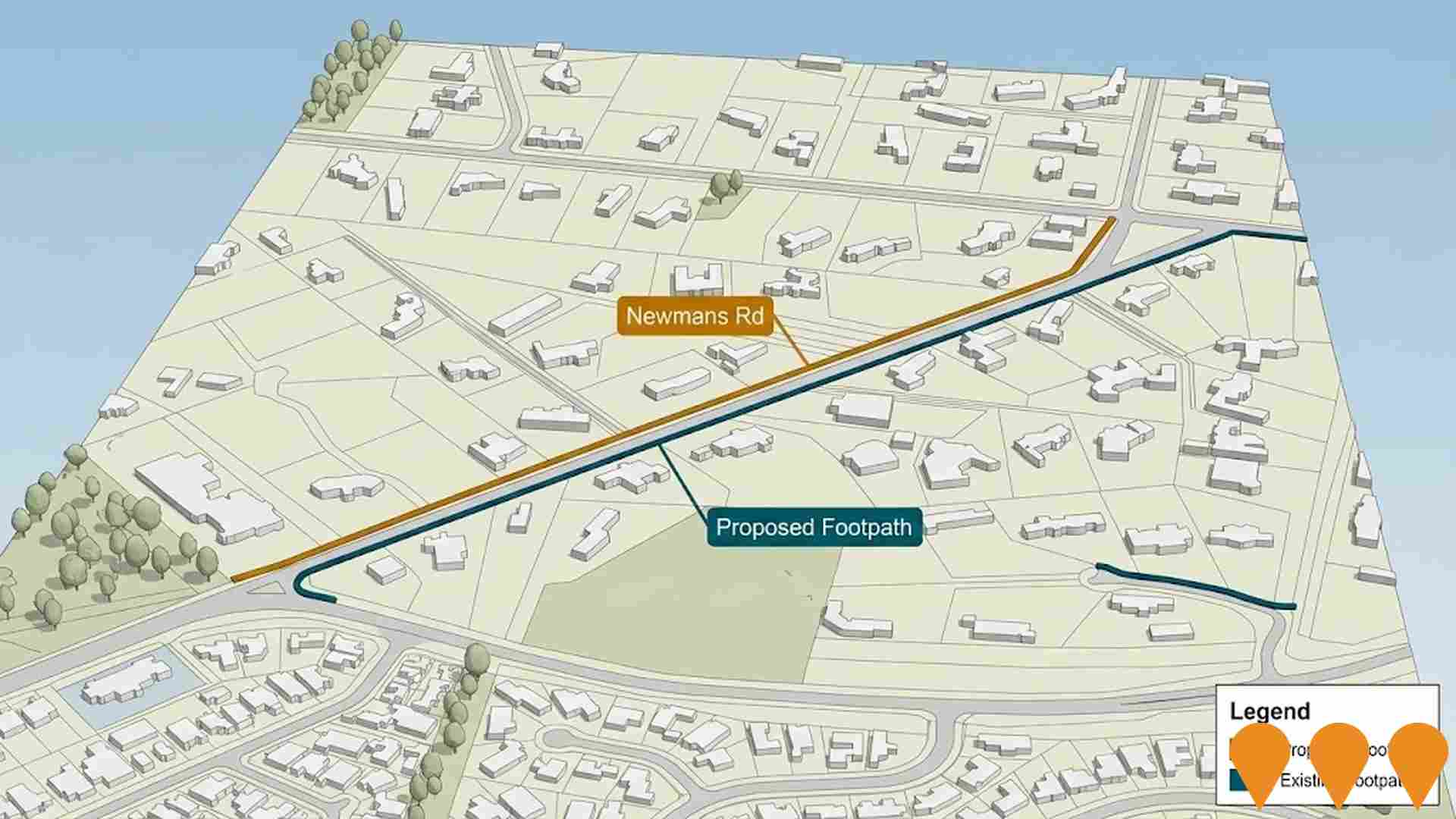Chart Color Schemes
est. as @ -- *
ABS ERP | -- people | --
2021 Census | -- people
Sales Activity
Curious about local property values? Filter the chart to assess the volume and appreciation (including resales) trends and regional comparisons, or scroll to the map below view this information at an individual property level.
Find a Recent Sale
Sales Detail
Population
Montmorency - Briar Hill has seen population growth performance typically on par with national averages when looking at short and medium term trends
Montmorency - Briar Hill's population is around 17,038 as of November 2025. This reflects an increase of 499 people since the 2021 Census, which reported a population of 16,539 people. The change was inferred from the estimated resident population of 16,961 from the ABS as of June 2024 and an additional 127 validated new addresses since the Census date. This level of population equates to a density ratio of 1,416 persons per square kilometer. Montmorency - Briar Hill's growth rate of 3.0% since the census positions it within 2.1 percentage points of the SA3 area's growth rate of 5.1%, demonstrating competitive growth fundamentals. Population growth was primarily driven by overseas migration, contributing approximately 60.4% of overall population gains during recent periods.
AreaSearch is adopting ABS/Geoscience Australia projections for each SA2 area, released in 2024 with a base year of 2022. For areas not covered by this data, AreaSearch utilises the VIC State Government's Regional/LGA projections released in 2023, adjusted using a method of weighted aggregation of population growth from LGA to SA2 levels. Growth rates by age group are applied across all areas for years 2032 to 2041. A significant population increase is forecast for the area, with an expected increase of 5,989 persons to 2041 based on the latest population numbers, representing a total increase of 34.7% over the 17-year period.
Frequently Asked Questions - Population
Development
Residential development activity is lower than average in Montmorency - Briar Hill according to AreaSearch's national comparison of local real estate markets
Montmorency - Briar Hill has seen approximately 49 dwellings granted development approval annually. Between FY21 and FY25, a total of 248 homes received approvals, with an additional 17 approved so far in FY26. Despite population decline during this period, housing supply has remained adequate relative to demand, resulting in a balanced market with diverse buyer options.
The average construction cost for new properties is $494,000, indicating developers target the premium market segment. Commercial approvals have reached $20.8 million this financial year, reflecting steady commercial investment activity. Compared to Greater Melbourne, Montmorency - Briar Hill exhibits significantly reduced construction levels (56.0% below regional average per person), which generally supports stronger demand and values for established properties. This activity is also below the national average, suggesting the area's established nature and potential planning limitations. Recent construction comprises 59.0% standalone homes and 41.0% townhouses or apartments, expanding medium-density options and offering a mix of housing alternatives across price brackets. This shift from the existing housing composition (currently 84.0% houses) indicates decreasing availability of developable sites and reflects changing lifestyles requiring more diverse, affordable housing options.
The area has approximately 349 people per dwelling approval, reflecting its established nature. Population forecasts project Montmorency - Briar Hill will gain 5,908 residents by 2041. If current construction levels persist, housing supply may lag population growth, potentially intensifying buyer competition and underpinning price growth.
Frequently Asked Questions - Development
Infrastructure
Montmorency - Briar Hill has strong levels of nearby infrastructure activity, ranking in the top 40% nationally
Changes to local infrastructure significantly impact an area's performance. AreaSearch has identified 25 projects likely to affect the region. Notable initiatives include Hurstbridge Rail Line upgrades between Watsonia and Eltham, Montmorency North Pavilion refurbishment, Level Crossing Removal - North Eastern Program Alliance along the Hurstbridge corridor, and Plenty River Trail upgrades. The following list details those most relevant.
Professional plan users can use the search below to filter and access additional projects.
INFRASTRUCTURE SEARCH
 Denotes AI-based impression for illustrative purposes only, not to be taken as definitive under any circumstances. Please follow links and conduct other investigations from the project's source for actual imagery. Developers and project owners wishing us to use original imagery please Contact Us and we will do so.
Denotes AI-based impression for illustrative purposes only, not to be taken as definitive under any circumstances. Please follow links and conduct other investigations from the project's source for actual imagery. Developers and project owners wishing us to use original imagery please Contact Us and we will do so.
Frequently Asked Questions - Infrastructure
Eltham and Diamond Creek Major Activity Centres Structure Plans
Comprehensive planning framework implementing the 2020 Structure Plans for Eltham and Diamond Creek through Amendments C143 and C144. The project guides sustainable growth, land use, and built form character across the activity centres until 2030. As of late 2025, Amendment C143 (Eltham Part A) has been submitted for Ministerial approval, while Amendment C144 (Diamond Creek) is scheduled for an independent panel hearing in December 2025.

Greensborough College Sports Facilities Upgrade
A $68 million initiative to enhance sports facilities across Melbourne's northern and eastern suburbs. The Greensborough College upgrade includes new synthetic sports surfaces, improved LED lighting, modernized change rooms, and enhanced accessibility features to promote community sports engagement.
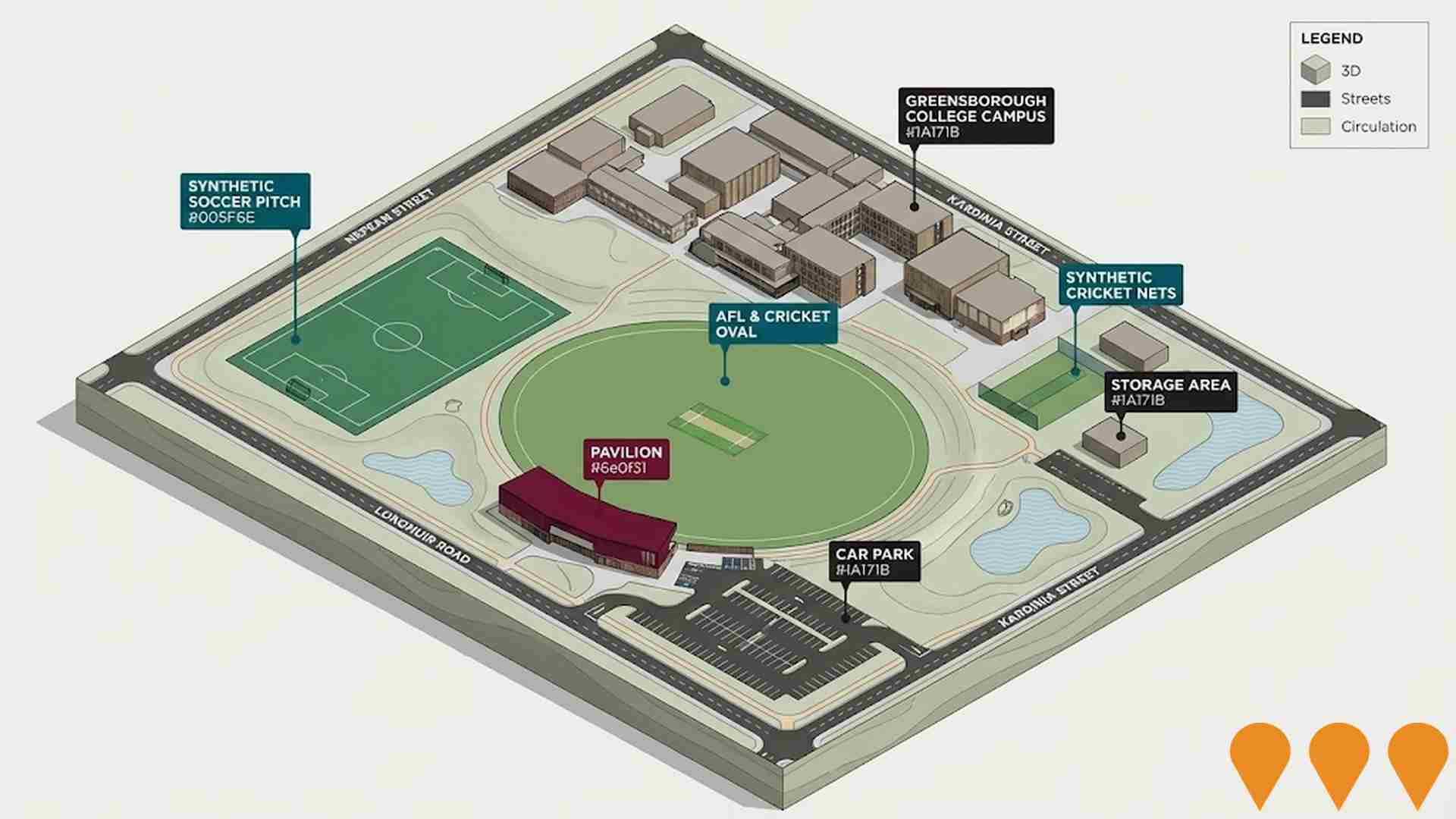
Hurstbridge Rail Line Upgrades (Watsonia-Eltham)
A $150 million upgrade of the Hurstbridge railway line between Watsonia and Eltham including track duplication, level crossing removals, station upgrades, new signalling systems, and accessibility improvements. The project includes an extended rail tunnel at Watsonia (on track for mid-2026 completion, making it Melbourne's third longest tunnel), new Greensborough station, and improved track infrastructure. Works will reduce travel times and increase service frequency on the line, with major rail systems upgrades scheduled for early 2025 requiring bus replacement services between Heidelberg and Eltham from January 31 to March 27.
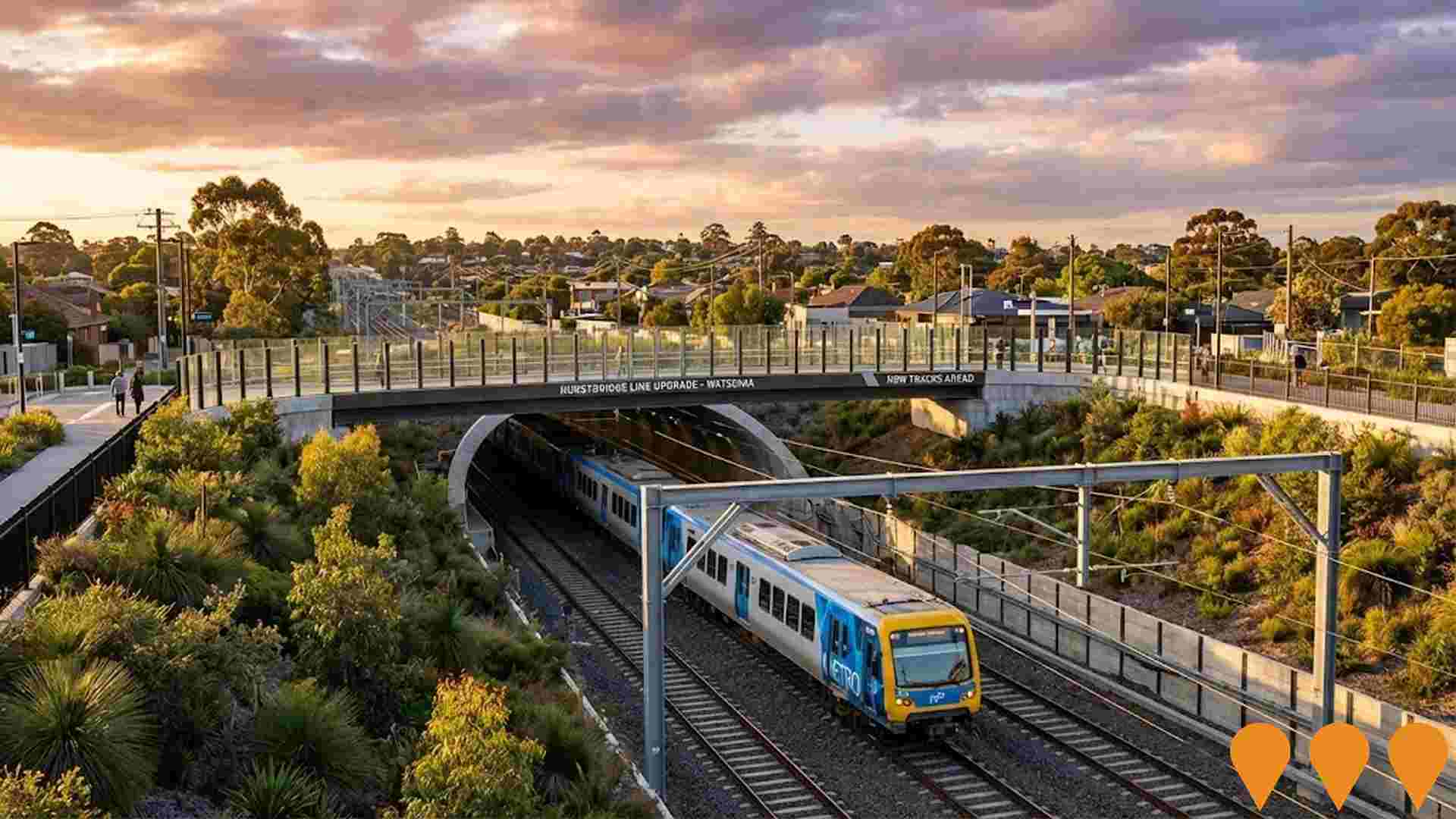
106-126 Main Street Greensborough Affordable Housing
A fast-tracked 17-storey mixed-use development under Victoria's Big Housing Build and Development Facilitation Program, delivering 211 affordable one- and two-bedroom dwellings managed by HousingFirst (a community housing provider). Includes ground-level retail and commercial spaces, 100 car parking spaces, communal areas, and new pedestrian links. Located near Greensborough train station, bus interchange, shops, parks and services.

Level Crossing Removal - North Eastern Program Alliance (Hurstbridge corridor)
Program alliance delivering level crossing removals and rail upgrades in Melbourne's north east. NEPA delivered Stage 1 of the Hurstbridge Line Upgrade (duplicate track Heidelberg-Rosanna, remove crossings at Grange Rd Alphington and Lower Plenty Rd Rosanna, build the new Rosanna Station). Subsequent corridor upgrades including the Hurstbridge Line Duplication delivered new stations at Greensborough and Montmorency, further track duplication and a shared path, with major construction completed in April 2025.

Montmorency North Pavilion Refurbishment
Refurbishment of the Montmorency North Pavilion to upgrade facilities, including changerooms, storerooms, gym, and umpires' rooms, to meet current compliance standards and support female participation in sports. Tenders for construction were sought by Banyule City Council, with the tender closing in July 2025. The project is a smaller refurbishment focusing on female-friendly facilities, delivered in 2025/26.

Montmorency Secondary College Sports Facilities
The project expanded the sports facilities at Montmorency Secondary College, including a new stadium increasing the number of courts from two to five, with a show court seating up to 1100 spectators, change rooms, meeting rooms, undercroft car parking, a gymnasium, kiosk, offices, and additional amenities. It supports physical education, community sporting programs, and local clubs like the Eltham Wildcats.
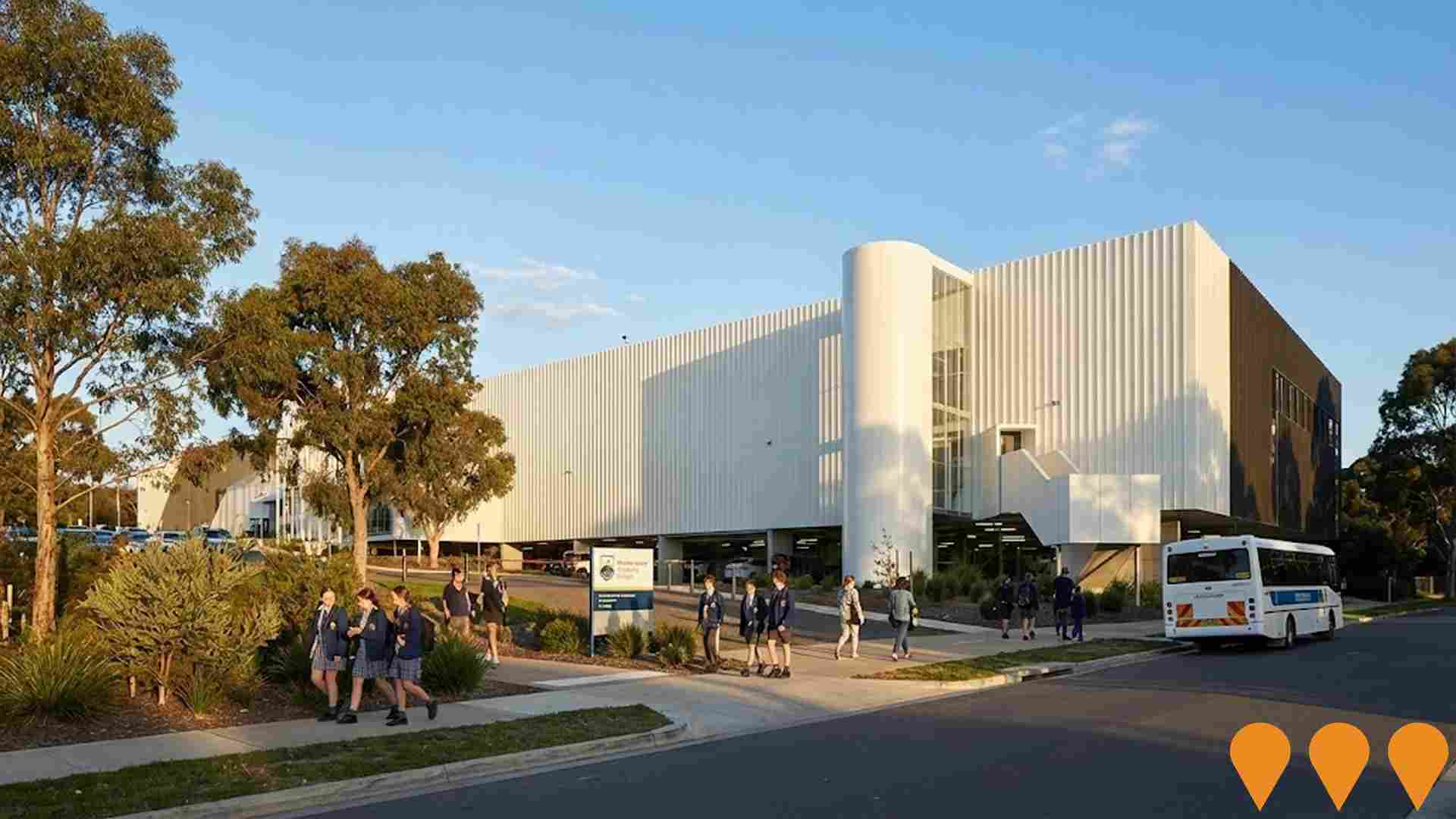
Montmorency Bowling Club Pavilion Upgrade
Upgrade of the Montmorency Bowling Club Pavilion, located at Petrie Park, as part of Banyule City Council's capital works program. The project included a major upgrade of the facilities, which was listed as completed in the Council's mid-year highlights report for July to December 2023. Another refurbishment focusing on female-friendly amenities was also completed by Kingdom Constructions Group for an estimated $250k.

Employment
AreaSearch analysis of employment trends sees Montmorency - Briar Hill performing better than 85% of local markets assessed across Australia
Montmorency-Briar Hill has an educated workforce with strong professional services representation. Its unemployment rate was 1.9% in June 2025, lower than Greater Melbourne's 4.6%.
Employment growth over the past year was estimated at 2.1%. As of June 2025, 9,530 residents were employed, with a participation rate similar to Greater Melbourne's 64.1%. Key employment sectors are health care & social assistance, construction, and education & training, with the latter having a particularly strong presence at 1.4 times the regional level. Transport, postal & warehousing has limited representation at 3.2%, compared to the regional average of 5.2%.
Employment opportunities locally may be limited as indicated by Census data comparing working population to resident population. Between June 2024 and June 2025, employment levels increased by 2.1% while labour force grew by 1.5%, reducing unemployment by 0.6 percentage points. In contrast, Greater Melbourne saw employment growth of 3.5%, labour force growth of 4.0%, and a rise in unemployment by 0.5 percentage points. Jobs and Skills Australia's national employment forecasts from May 2025 project overall employment growth of 6.6% over five years and 13.7% over ten years, with varying rates across industry sectors. Applying these projections to Montmorency-Briar Hill's employment mix suggests local growth of approximately 6.9% over five years and 14.0% over ten years.
Frequently Asked Questions - Employment
Income
Income metrics indicate excellent economic conditions, with the area achieving higher performance than 75% of national locations assessed by AreaSearch
AreaSearch's aggregation of latest postcode level ATO data shows Montmorency - Briar Hill had a median taxpayer income of $59,944 in financial year 2022. The average was $79,435. These figures are among the highest in Australia and compare to Melbourne-wide levels of $54,892 and $73,761 respectively. Based on Wage Price Index growth of 12.16% since financial year 2022, current estimates would be approximately $67,233 (median) and $89,094 (average) as of September 2025. Census data indicates household, family and personal incomes in Montmorency - Briar Hill cluster around the 72nd percentile nationally. The dominant earnings bracket is $1,500 - 2,999 with 31.8% of residents (5,418 people). This reflects metropolitan patterns where 32.8% fall within this range. High earners account for 30.6%, indicating strong economic capacity. Housing consumes 13.5% of income and residents rank in the 74th percentile for disposable income. The area's SEIFA income ranking places it in the 8th decile.
Frequently Asked Questions - Income
Housing
Montmorency - Briar Hill is characterized by a predominantly suburban housing profile, with above-average rates of outright home ownership
Dwelling structure in Montmorency - Briar Hill, as evaluated at the latest Census held on 28 August 2016, comprised 84.2% houses and 15.8% other dwellings (semi-detached, apartments, 'other' dwellings), compared to Melbourne metro's 76.0% houses and 24.0% other dwellings. Home ownership in Montmorency - Briar Hill stood at 41.1%, with mortgaged dwellings at 41.3% and rented dwellings at 17.6%. The median monthly mortgage repayment in the area was $2,167, aligning with Melbourne metro's average, while the median weekly rent figure was $415, compared to Melbourne metro's $399. Nationally, Montmorency - Briar Hill's mortgage repayments were higher than the Australian average of $1,863, recorded as of 2017, and rents were substantially above the national figure of $375 for the same period.
Frequently Asked Questions - Housing
Household Composition
Montmorency - Briar Hill has a typical household mix, with a fairly typical median household size
Family households account for 74.3% of all households, including 34.5% couples with children, 27.3% couples without children, and 11.4% single parent families. Non-family households make up the remaining 25.7%, consisting of 24.3% lone person households and 1.5% group households. The median household size is 2.5 people, which aligns with the Greater Melbourne average.
Frequently Asked Questions - Households
Local Schools & Education
Educational achievement in Montmorency - Briar Hill places it within the top 10% nationally, reflecting strong academic performance and high qualification levels across the community
The area's educational profile is notable regionally. University qualification rates exceed the Australian average of 30.4%, with 38.0% of residents aged 15+ holding such qualifications. This figure is also higher than that of the SA4 region (32.8%).
Bachelor degrees are most common at 24.3%, followed by postgraduate qualifications (8.4%) and graduate diplomas (5.3%). Vocational credentials are prominent, with 30.5% of residents aged 15+ holding such qualifications. Advanced diplomas account for 12.3% and certificates for 18.2%. Educational participation is high, with 27.9% of residents currently enrolled in formal education. This includes 10.1% in primary education, 7.4% in secondary education, and 4.7% pursuing tertiary education. Seven schools operate within Montmorency - Briar Hill, educating approximately 2,816 students. The area demonstrates significant socio-educational advantages and academic achievement, with an ICSEA score of 1107. Education provision is balanced with six primary and one secondary school serving distinct age groups.
Frequently Asked Questions - Education
Schools Detail
Nearby Services & Amenities
Transport
Transport servicing is good compared to other areas nationally based on assessment of service frequency, route connectivity and accessibility
Montmorency - Briar Hill has 58 active public transport stops offering a mix of train and bus services. These stops are served by 11 individual routes, collectively facilitating 5,780 weekly passenger trips. Transport accessibility is rated good, with residents typically situated 270 meters from the nearest stop.
Service frequency averages 825 trips per day across all routes, translating to approximately 99 weekly trips per stop.
Frequently Asked Questions - Transport
Transport Stops Detail
Health
Montmorency - Briar Hill's residents are healthier than average in comparison to broader Australia with a fairly standard level of common health conditions seen across both young and old age cohorts
Health data shows Montmorency - Briar Hill residents have relatively positive health outcomes, with common conditions seen across both young and old age groups at a fairly standard level.
Approximately 59% of the total population (10,120 people) has private health cover, which is exceptionally high. The most prevalent medical conditions are arthritis and asthma, affecting 8.4 and 8.0% of residents respectively. 68.1% of residents declare themselves completely free from medical ailments, compared to 69.3% across Greater Melbourne. 22.0% of residents are aged 65 and over (3,755 people), higher than the 19.8% in Greater Melbourne. Health outcomes among seniors are above average, broadly aligning with the general population's health profile.
Frequently Asked Questions - Health
Cultural Diversity
In terms of cultural diversity, Montmorency - Briar Hill records figures broadly comparable to the national average, as found in AreaSearch's assessment of a number of language and cultural background related metrics
Montmorency-Briar Hill's population is culturally diverse, with 82.6% born in Australia, 92.1% being citizens, and 89.2% speaking English only at home. Christianity is the dominant religion, practiced by 45.3%. Judaism, however, is slightly overrepresented at 0.1%, compared to Greater Melbourne's 0.2%.
The top three ancestry groups are English (27.4%), Australian (24.8%), and Irish (10.4%). Notably, Italian ancestry is overrepresented at 6.2% (regional average: 7.7%), Macedonian at 0.8% (vs 1.1%), and Maltese at 0.8%.
Frequently Asked Questions - Diversity
Age
Montmorency - Briar Hill hosts an older demographic, ranking in the top quartile nationwide
The median age in Montmorency - Briar Hill is 42 years, significantly higher than Greater Melbourne's average of 37 and Australia's national average of 38 years. The 65-74 age group constitutes 11.7%, compared to Greater Melbourne, while the 25-34 cohort stands at 8.2%. Post-2021 Census data reveals that the 15 to 24 age group has increased from 9.6% to 11.1%, and the 75 to 84 cohort has risen from 6.7% to 7.7%. Conversely, the 25 to 34 cohort has decreased from 10.0% to 8.2%. Population forecasts for 2041 indicate substantial demographic changes in Montmorency - Briar Hill, with the 75 to 84 group expected to grow by 81%, adding 1,073 people and reaching a total of 2,392 from 1,318. In contrast, the 0 to 4 cohort is projected to grow minimally by 4%, an increase of just 32 people.
